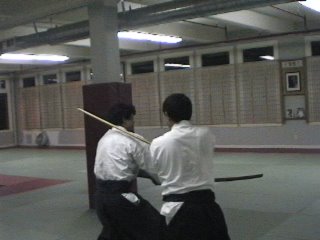Einstein and aikido

What could Albert Einstein have to do with aikido? Obviously he did not have a knowledge of the formal throws and falls of the Japanese martial art. But he was someone who sought to understand the universe on much deeper terms than existed at that time. Just as Ueshiba Osensei probably felt that before his aikido there was no existing martial art at his time that could teach him the root source of things, so Einstein had to create his own physics to further explain the workings of the universe. Both aikido and Einsteinian physics represent the journey of two remarkable men who sought the deeper experiential truth of things as opposed to just reworking existing knowledge. There are some of Einstein’s sayings that have definitely inspired me in my quest to grasp aikido:
1. “All I want to do is to think God’s thoughts. The rest are just details.” Detail consciousness tends to keep us thinking and behaving like everybody else. God, representing the creative force and intelligence that created the universe, cannot be reduced to a mere detail. If Einstein could think like God, he would comprehend the workings of the universe from the standpoint of its source.
2. “Imagination is more important than knowledge.” Where were cell phones 30 years ago? What about ipods and lap top computers? They existed only in imagination. So imagination, as opposed to being something false or undependable, is really the template from which new things move from the field of potential to existing reality. Anything truly new, as opposed to recycling old knowledge, must come from the imagination.
What else might Einstein and Ueshiba Osensei have had in common? It is said that everyday we think from 40,000 to 52,000 thoughts a day. Unfortunately, they are. pretty much the same thoughts. I feel that people like Einstein and Osensei probably think fewer yet deeper thoughts than normal people. They say that really creativity exists in the silence, the gap between the thoughts. This is probably where they hung out. So where is this gap/silence? It is probably in the body. Einstein would visualize himself running at light speed in beam of light. He was not an outstanding mathematician, so his genius was in being able to”see” things from a very different perspective. Likewise, Ueshiba Osensei studied things like time and space through his budo training. One might see him as an energy scientist as opposed to simply just a martial artist.
How can we evaluate such seeming different people as Einstein and Ueshiba osensei? I am probably in a very distinct minority, but from my perspective, Ueshiba Osensei’s achievement was much greater than Einstein’s. Einstein sought a Unified Field Theory that would unify his physics, Newtonian physics, and quantum physics. He never succeeded. This is still being sought by physicists today. I feel Ueshiba Osensei through his body and movement WAS the Unified Field Theory.
Through the magic of youtube here is a clip of Albert Einstein:




